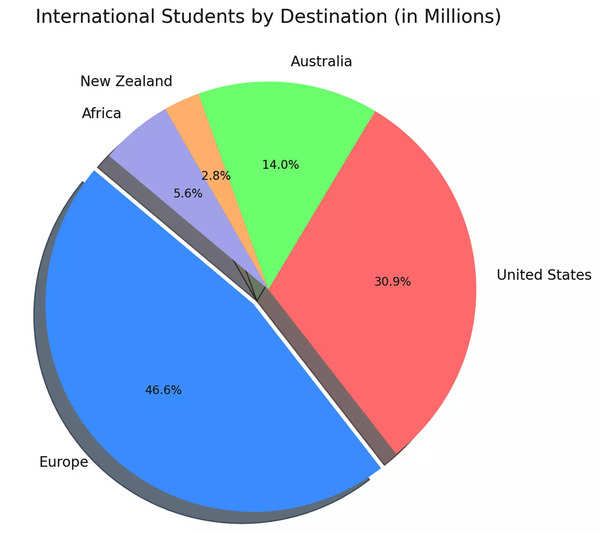
The educational landscape is changing as Europe emerges as a top destination for international students. In 2022, approximately 1.66 million international students were enrolled in European universities, a number that is expected to increase as more students choose Europe for its diverse educational and cultural advantages. Major countries such as Germany, France, and the Netherlands are taking advantage of policy reforms, affordable education, and strong research opportunities, attracting students from around the world.
As student numbers change due to changes in immigration policies and rising costs in the United States, Canada, Australia and other popular study destinations, Europe is becoming increasingly popular as a stable and affordable educational hub. Programs like Erasmus+ and government-backed initiatives provide strong incentives for students seeking high-quality education with manageable tuition and living costs.
Europe vs. other popular destinations
Compared to the United States, which will host around 1.1 million international students by 2021, Europe’s appeal lies in its affordability and less restrictive immigration policies. While Australia and New Zealand also offer competitive education systems, their international student populations (500,000 and 100,000 respectively) are significantly lower than Europe’s 1.66 million. Student retention rates in Europe, along with its expanding PBSA sector and supportive policies, continue to make Europe an attractive destination for international students from all regions.
Europe’s combination of academic excellence, diverse cultural exposure, and career-enhancing opportunities is cementing its position as a leading destination for international students. As more students around the world seek affordable, high-quality education with global job prospects, Europe’s educational landscape is likely to grow, transforming the continent into a major global academic hub.

Reasons why international students are flocking to European universities
Accessible and Accessible Education: Europe offers a unique combination of low-cost or free education options, especially in countries like Germany and Norway. German universities, hosting approximately 403,500 international students (24% of Europe’s total), offer free or low-cost tuition at many public institutions, making quality education accessible regardless of students’ economic background. France, the second-most popular destination, attracts approximately 263,500 international students due to its mix of affordable tuition and world-renowned universities. According to a report by Beyond Beds & Benches, Europe’s affordable education system is the primary driver behind its growing appeal to global students.
High quality education and research opportunities: Europe is home to many globally recognized universities that attract students for their rigorous academics and innovative research. According to Beyond Beds & Benches, European universities are at the forefront of research in fields such as engineering, social sciences, and environmental studies, enhancing their global reputation. Universities in countries such as the Netherlands and Sweden are known for strong industry collaboration, providing students with internship opportunities and research experience in top fields such as technology, finance, and healthcare. This practical focus is particularly attractive to students looking to gain valuable industry experience during their studies.
Diverse Cultural Experience and Multilingual Education: Europe’s cultural richness is another factor driving international students to the continent. With open borders between EU countries and affordable travel options, students can explore multiple cultures within a single study program. In addition, many universities now offer programs in English, which appeals to non-native speakers and contributes to Europe’s increasingly multicultural student body. In 2022, 43% of international students in Europe came from other European countries, while 25% came from Asia and 17% from Africa, highlighting Europe’s attractiveness for students from different backgrounds.
Career opportunities and post-study work visas: One of the strongest incentives for international students is Europe’s supportive post-study work visa policies. Countries such as Germany, the Netherlands and Ireland offer extended work visas after graduation, enabling students to gain professional experience in Europe’s competitive job market. The UK, which has 605,000 international students (by 2023), also offers a two-year post-study work visa, which contributes to its attractiveness for students seeking global career exposure. Furthermore, European universities often have strong ties to industry, especially in growing sectors such as technology and finance, which allow students to get internships and connections that increase their employability.
Challenges Europe may face to meet growing demand
As international student numbers continue to grow, Europe is facing a major challenge: to meet the unprecedented demand for quality student accommodation, especially in major cities such as London, Paris and Barcelona. Rapid growth in international student numbers has led to increased demand for student accommodation, with an estimated shortage of 3 million beds across Europe. The Beyond Beds & Benches report projects a €450 billion opportunity in the purpose-built student accommodation (PBSA) sector over the next five years. High occupancy rates (98% in 2023) and growing investment are meeting the urgent demand for housing, especially in cities such as London, Paris and Barcelona. In Germany, for example, recent reforms streamline planning approvals for student housing, while the UK offers tax breaks and grants to encourage student housing development.
Policy reforms to support international education
European governments actively support policies that make studying in Europe more accessible to international students. The Erasmus+ programme, one of the EU’s flagship initiatives, facilitates student mobility and cross-border education, benefiting hundreds of thousands of students each year. Additionally, countries such as Germany and the UK are constantly revising their visa and residency policies to attract more students. These policy efforts create a particularly welcoming environment for students from middle-income countries who may face economic barriers to other destinations.